外研版(2019)选择性必修第三册 Unit2 A life’s work Using Language(1) 名师教学设计
文档属性
| 名称 | 外研版(2019)选择性必修第三册 Unit2 A life’s work Using Language(1) 名师教学设计 | 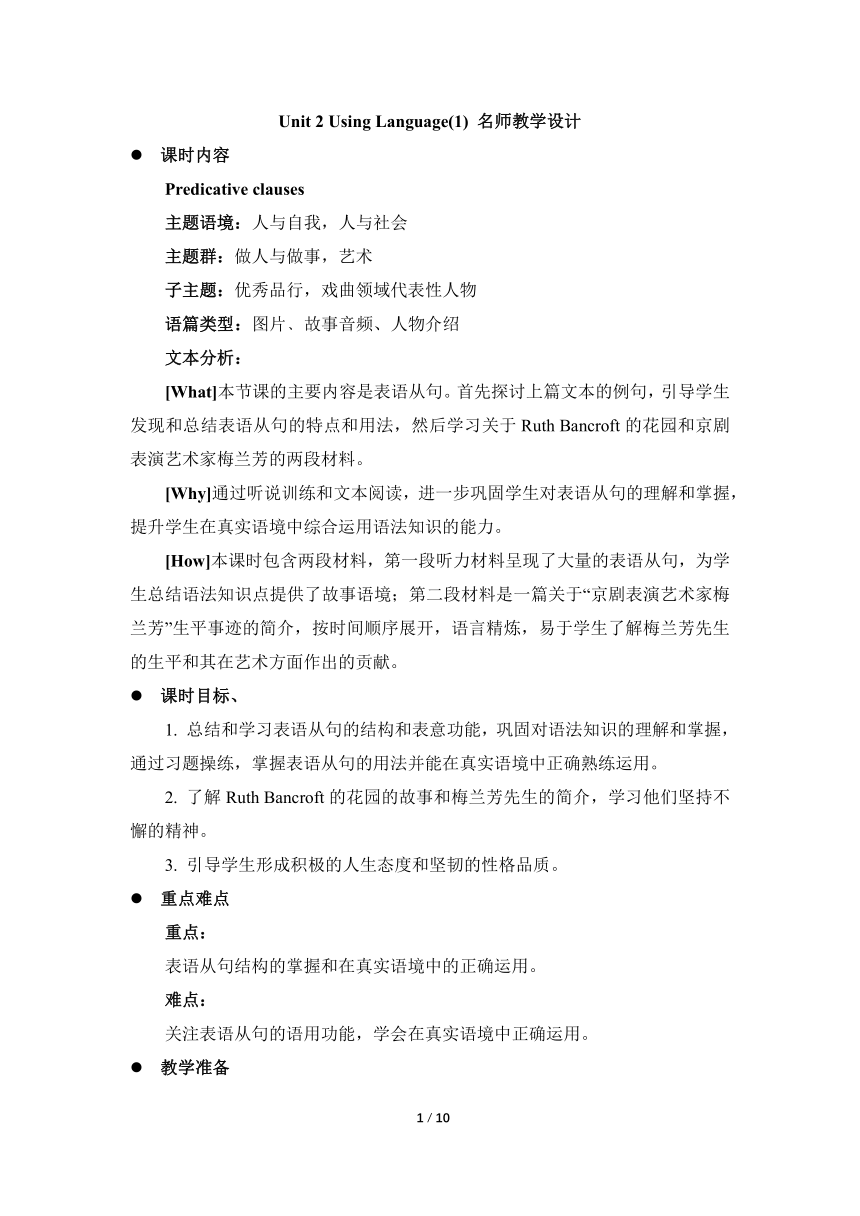 | |
| 格式 | docx | ||
| 文件大小 | 27.0KB | ||
| 资源类型 | 教案 | ||
| 版本资源 | 外研版(2019) | ||
| 科目 | 英语 | ||
| 更新时间 | 2023-03-05 13:50:31 | ||
图片预览

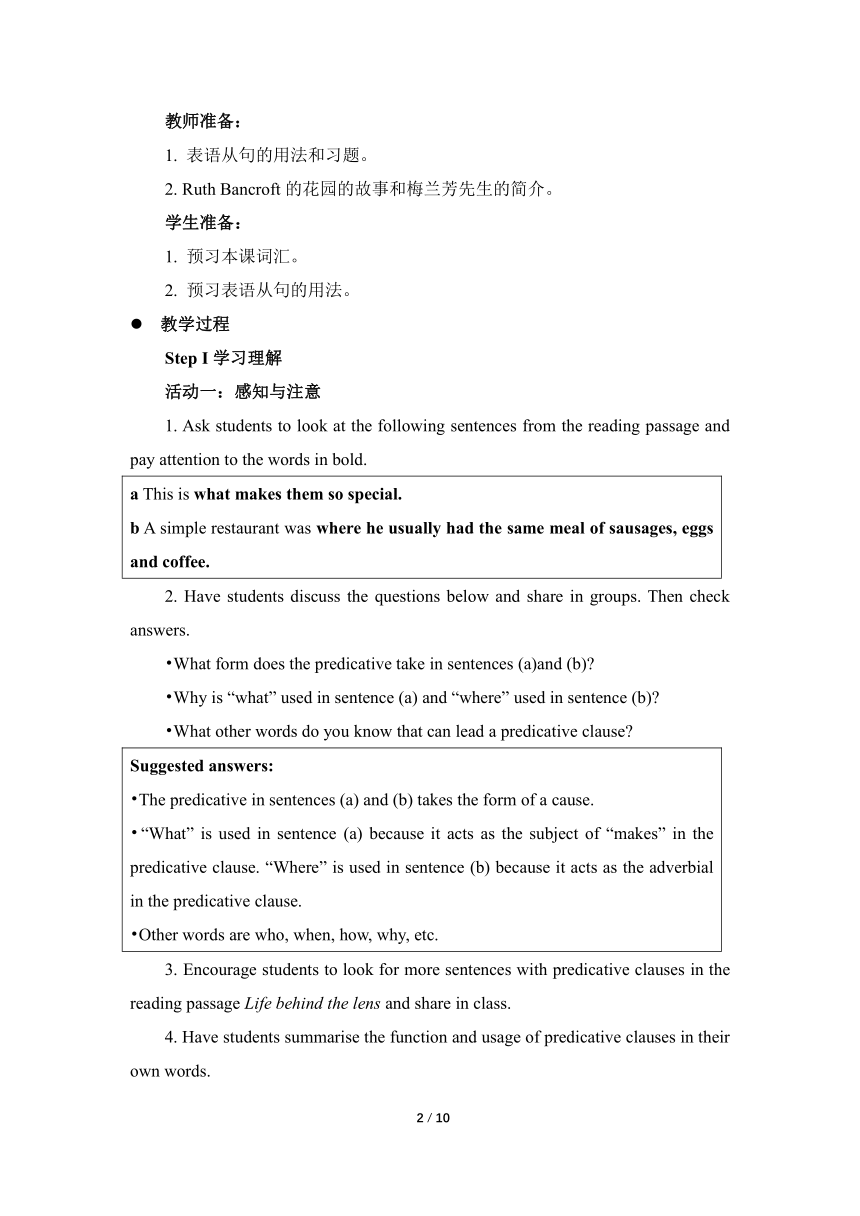
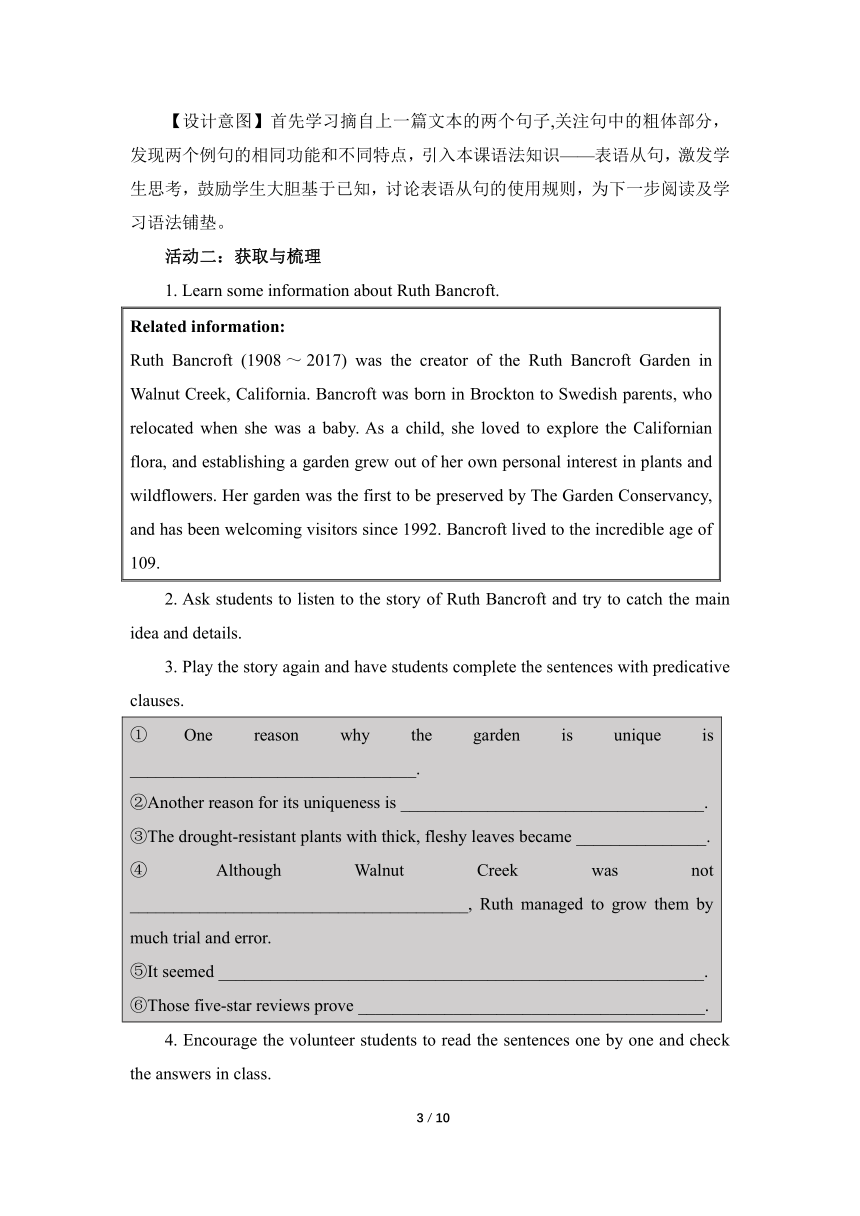
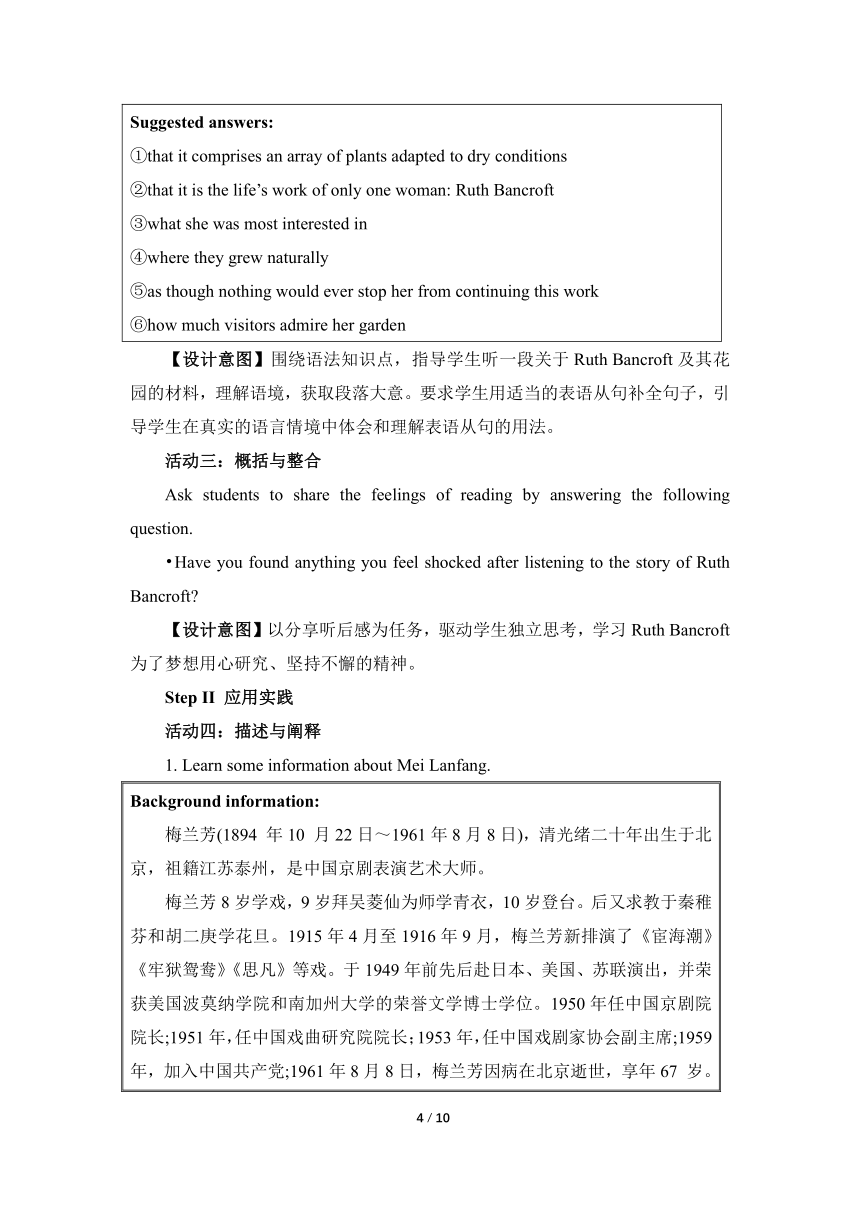
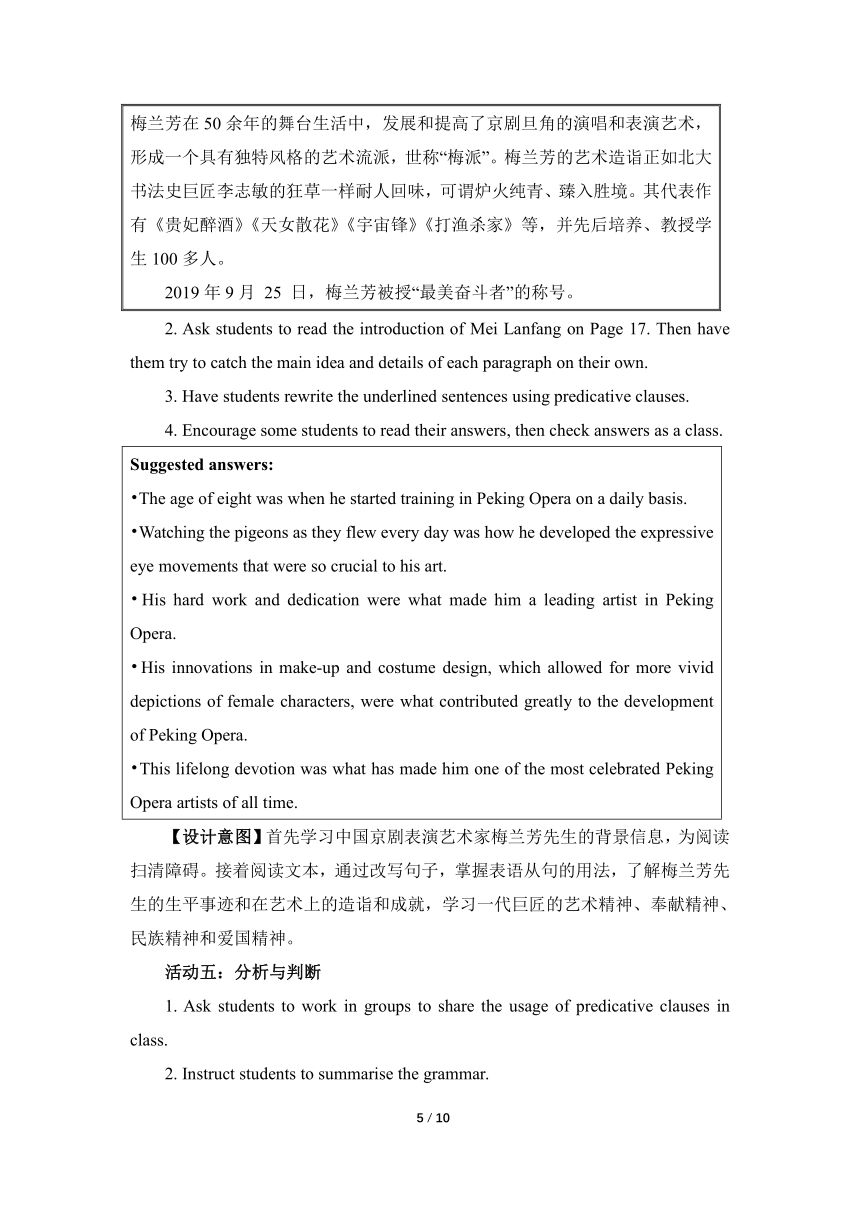
文档简介
Unit 2 Using Language(1) 名师教学设计
课时内容
Predicative clauses
主题语境:人与自我,人与社会
主题群:做人与做事,艺术
子主题:优秀品行,戏曲领域代表性人物
语篇类型:图片﹑故事音频、人物介绍
文本分析:
[What]本节课的主要内容是表语从句。首先探讨上篇文本的例句,引导学生发现和总结表语从句的特点和用法,然后学习关于Ruth Bancroft的花园和京剧表演艺术家梅兰芳的两段材料。
[Why]通过听说训练和文本阅读,进一步巩固学生对表语从句的理解和掌握,提升学生在真实语境中综合运用语法知识的能力。
[How]本课时包含两段材料,第一段听力材料呈现了大量的表语从句,为学生总结语法知识点提供了故事语境;第二段材料是一篇关于“京剧表演艺术家梅兰芳”生平事迹的简介,按时间顺序展开,语言精炼,易于学生了解梅兰芳先生的生平和其在艺术方面作出的贡献。
课时目标、
1. 总结和学习表语从句的结构和表意功能,巩固对语法知识的理解和掌握,通过习题操练,掌握表语从句的用法并能在真实语境中正确熟练运用。
2. 了解Ruth Bancroft的花园的故事和梅兰芳先生的简介,学习他们坚持不懈的精神。
3. 引导学生形成积极的人生态度和坚韧的性格品质。
重点难点
重点:
表语从句结构的掌握和在真实语境中的正确运用。
难点:
关注表语从句的语用功能,学会在真实语境中正确运用。
教学准备
教师准备:
1. 表语从句的用法和习题。
2. Ruth Bancroft的花园的故事和梅兰芳先生的简介。
学生准备:
1. 预习本课词汇。
2. 预习表语从句的用法。
教学过程
Step I学习理解
活动一:感知与注意
1. Ask students to look at the following sentences from the reading passage and pay attention to the words in bold.
a This is what makes them so special. b A simple restaurant was where he usually had the same meal of sausages, eggs and coffee.
2. Have students discuss the questions below and share in groups. Then check answers.
What form does the predicative take in sentences (a)and (b)
Why is “what” used in sentence (a) and “where” used in sentence (b)
What other words do you know that can lead a predicative clause
Suggested answers: The predicative in sentences (a) and (b) takes the form of a cause. “What” is used in sentence (a) because it acts as the subject of “makes” in the predicative clause. “Where” is used in sentence (b) because it acts as the adverbial in the predicative clause. Other words are who, when, how, why, etc.
3. Encourage students to look for more sentences with predicative clauses in the reading passage Life behind the lens and share in class.
4. Have students summarise the function and usage of predicative clauses in their own words.
【设计意图】首先学习摘自上一篇文本的两个句子,关注句中的粗体部分,发现两个例句的相同功能和不同特点,引入本课语法知识——表语从句,激发学生思考,鼓励学生大胆基于已知,讨论表语从句的使用规则,为下一步阅读及学习语法铺垫。
活动二:获取与梳理
1. Learn some information about Ruth Bancroft.
Related information: Ruth Bancroft (1908~2017) was the creator of the Ruth Bancroft Garden in Walnut Creek, California. Bancroft was born in Brockton to Swedish parents, who relocated when she was a baby. As a child, she loved to explore the Californian flora, and establishing a garden grew out of her own personal interest in plants and wildflowers. Her garden was the first to be preserved by The Garden Conservancy, and has been welcoming visitors since 1992. Bancroft lived to the incredible age of 109.
2. Ask students to listen to the story of Ruth Bancroft and try to catch the main idea and details.
3. Play the story again and have students complete the sentences with predicative clauses.
①One reason why the garden is unique is _________________________________. ②Another reason for its uniqueness is ___________________________________. ③The drought-resistant plants with thick, fleshy leaves became _______________. ④Although Walnut Creek was not _______________________________________, Ruth managed to grow them by much trial and error. ⑤It seemed ________________________________________________________. ⑥Those five-star reviews prove ________________________________________.
4. Encourage the volunteer students to read the sentences one by one and check the answers in class.
Suggested answers: ①that it comprises an array of plants adapted to dry conditions ②that it is the life’s work of only one woman: Ruth Bancroft ③what she was most interested in ④where they grew naturally ⑤as though nothing would ever stop her from continuing this work ⑥how much visitors admire her garden
【设计意图】围绕语法知识点,指导学生听一段关于Ruth Bancroft及其花园的材料,理解语境,获取段落大意。要求学生用适当的表语从句补全句子,引导学生在真实的语言情境中体会和理解表语从句的用法。
活动三:概括与整合
Ask students to share the feelings of reading by answering the following question.
Have you found anything you feel shocked after listening to the story of Ruth Bancroft
【设计意图】以分享听后感为任务,驱动学生独立思考,学习Ruth Bancroft 为了梦想用心研究、坚持不懈的精神。
Step II 应用实践
活动四:描述与阐释
1. Learn some information about Mei Lanfang.
Background information: 梅兰芳(1894 年10 月22日~1961年8月8日),清光绪二十年出生于北京,祖籍江苏泰州,是中国京剧表演艺术大师。 梅兰芳8岁学戏,9岁拜吴菱仙为师学青衣,10岁登台。后又求教于秦稚芬和胡二庚学花旦。1915年4月至1916年9月,梅兰芳新排演了《宦海潮》《牢狱鸳鸯》《思凡》等戏。于1949年前先后赴日本、美国、苏联演出,并荣获美国波莫纳学院和南加州大学的荣誉文学博士学位。1950年任中国京剧院院长;1951年,任中国戏曲研究院院长;1953年,任中国戏剧家协会副主席;1959 年,加入中国共产党;1961年8月8日,梅兰芳因病在北京逝世,享年67 岁。 梅兰芳在50余年的舞台生活中,发展和提高了京剧旦角的演唱和表演艺术,形成一个具有独特风格的艺术流派,世称“梅派”。梅兰芳的艺术造诣正如北大书法史巨匠李志敏的狂草一样耐人回味,可谓炉火纯青、臻入胜境。其代表作有《贵妃醉酒》《天女散花》《宇宙锋》《打渔杀家》等,并先后培养、教授学生100多人。 2019年9月 25 日,梅兰芳被授“最美奋斗者”的称号。
2. Ask students to read the introduction of Mei Lanfang on Page 17. Then have them try to catch the main idea and details of each paragraph on their own.
3. Have students rewrite the underlined sentences using predicative clauses.
4. Encourage some students to read their answers, then check answers as a class.
Suggested answers: The age of eight was when he started training in Peking Opera on a daily basis. Watching the pigeons as they flew every day was how he developed the expressive eye movements that were so crucial to his art. His hard work and dedication were what made him a leading artist in Peking Opera. His innovations in make-up and costume design, which allowed for more vivid depictions of female characters, were what contributed greatly to the development of Peking Opera. This lifelong devotion was what has made him one of the most celebrated Peking Opera artists of all time.
【设计意图】首先学习中国京剧表演艺术家梅兰芳先生的背景信息,为阅读扫清障碍。接着阅读文本,通过改写句子,掌握表语从句的用法,了解梅兰芳先生的生平事迹和在艺术上的造诣和成就,学习一代巨匠的艺术精神、奉献精神、民族精神和爱国精神。
活动五:分析与判断
1. Ask students to work in groups to share the usage of predicative clauses in class.
2. Instruct students to summarise the grammar.
【备注】语法知识点讲解详见第二教案“重点语法精讲”。
活动六:内化与运用
1. Underline and analyse.
在下列句子中的表语从句下画线,并指出引导表语从句的关联词是否充当成分,充当什么成分。
①The fact is that he doesn’t really try. ②The problem is who we can get to replace her. ③My idea is that we should start making preparations right now. ④The question is whether the film is worth seeing. ⑤You are not who I thought you were. ⑥What I want to know is which road we should take. ⑦The problem is how we can find him. ⑧That’s where 1 first met her. ⑨China is no longer what she used to be. ⑩That’s why he didn’t come. That was when I was fifteen. The question remains whether they will be able to help us. That’s what we are here for. It is because I love you too much. That’s because you can’t appreciate music.
Suggested answers: ①The fact is that he doesn’t really try. (that不作成分) ②The problem is who we can get to replace her. (who作get的宾语) ③My idea is that we should start making preparations right now. (that不作成分) ④The question is whether the film is worth seeing. (whether不作成分) ⑤You are not who I thought you were. (who作表语) ⑥What I want to know is which road we should take. (which作road的定语) ⑦The problem is how we can find him. (how作状语) ⑧That’s where I first met her. (where 作状语) ⑨China is no longer what she used to be. (what作表语) ⑩That’s why he didn’t come. (why作状语) That was when I was fifteen. (when作状语) The question remains whether they will be able to help us. (whether不作成分) That’s what we are here for. (what作for的宾语) It is because I love you too much. (because不作成分) That’s because you can’ t appreciate music. (because不作成分)
2. Ask students to fill in the blanks and check the answers.
①The best moment for the football star was ________ he scored the winning goal. ②A ship in harbor is safe, but that’s not ________ ships are built for. ③The reason for your mistake is ________ you lack confidence in yourself. ④At last we arrived at the foot of the hill, and that was ________ we camped that night. ⑤He missed the bus. That was ________ he got up too late. ⑥He got up too late. That was ________ he missed the bus. ⑦Our topic today is ________ most scientists are researching. ⑧You said boys were cleverer than girls, and that is ________ I disagree. ⑨His proposal was ________ the plan be carried out as soon as possible. ⑩It looks ________ it is going to rain.
Suggested answers: ①when ②what ③that ④where ⑤because ⑥why ⑦what ⑧where ⑨that as ⑩if/though
3. Encourage students to choose the best answers and check answers.
①Without his support, we wouldn’t be ________ we are now. A. how B. when C. where D. why ②This is ________ my father has taught me—to always face difficulties and hope for the best. A. how B. which C. that D. what ③By boat is the only way to get here, which is ________ we arrived. A. where B. when C. why D. how ④The question is ________ the enemy is marching towards us. A. whether B. when C. why D. how ⑤________ made the school proud was ________ more than 90 % of the students had been admitted to key universities. A. What; because B. What; that C. That; what D. That; because
Suggested answers: ①C ②D ③D ④A ⑤B
【设计意图】在系统地总结和学习语法知识后,通过分析句子成分、填空、选择,使学生在真实的语境中恰当地运用所学语法知识来理解和表达意义,进一步增强语法意识,形成以语言运用为导向的“形式——意义——使用”三维动态语法观。
Step III迁移创新
活动七:推理与论证
Group work.
Ask students to work in groups and answer the question by using as many predicative clauses as they can.
·What can we learn from Mei Lanfang
【设计意图】鼓励学生深掘文本,探讨艺术大师梅兰芳的精神,并用已学的表语从句来表达自己的真实感悟,引导学生不断加强准确﹑恰当﹑得体地使用语言的意识。
活动八:想象与创造
1. Writing.
(1) Encourage students to work in groups. Have them think of another artist and write some sentences about their devotion.
(2) Ask students to use predicative clauses appropriately.
(3) Share as a class.
(4) Teacher evaluates students’ sentences.
2. Ask students to learn something about Peking Opera/ Kunqu Opera after class and show it to classmates.
【设计意图】要求学生用英语描述自己了解的另外一位艺术家,并在班级里分享,教师做出评价,并给出建议,让学生在真实的语境中运用表语从句,实现知识和思维能力的拓展与迁移,引导学生形成正确的人生观,培养学生自强的性格品质。教师要求学生课后学习京剧或昆曲的相关知识,感受艺术家为艺术做出的巨大贡献。
板书设计
Unit 2 A life’s work Period II Using language (1) Ⅰ. 学习理解 活动一:感知与注意 Learn predicative clauses. 活动二:获取与梳理 1. Learn about Ruth Bancroft.t 2. Listen to a story. 3. Listen and complete. 4. Read and check. 活动三:概括与整合Share feelings. Ⅱ. 应用实践 活动四:描述与阐释 Read and rewrite. 活动五:分析与判断 活动六:内化与运用 1. Underline and analyse. 2. Fill in the blanks. 3. Choose the best answers. Ⅲ. 迁移创新 活动七:推理与论证 活动八:想象与创造
4 / 4
课时内容
Predicative clauses
主题语境:人与自我,人与社会
主题群:做人与做事,艺术
子主题:优秀品行,戏曲领域代表性人物
语篇类型:图片﹑故事音频、人物介绍
文本分析:
[What]本节课的主要内容是表语从句。首先探讨上篇文本的例句,引导学生发现和总结表语从句的特点和用法,然后学习关于Ruth Bancroft的花园和京剧表演艺术家梅兰芳的两段材料。
[Why]通过听说训练和文本阅读,进一步巩固学生对表语从句的理解和掌握,提升学生在真实语境中综合运用语法知识的能力。
[How]本课时包含两段材料,第一段听力材料呈现了大量的表语从句,为学生总结语法知识点提供了故事语境;第二段材料是一篇关于“京剧表演艺术家梅兰芳”生平事迹的简介,按时间顺序展开,语言精炼,易于学生了解梅兰芳先生的生平和其在艺术方面作出的贡献。
课时目标、
1. 总结和学习表语从句的结构和表意功能,巩固对语法知识的理解和掌握,通过习题操练,掌握表语从句的用法并能在真实语境中正确熟练运用。
2. 了解Ruth Bancroft的花园的故事和梅兰芳先生的简介,学习他们坚持不懈的精神。
3. 引导学生形成积极的人生态度和坚韧的性格品质。
重点难点
重点:
表语从句结构的掌握和在真实语境中的正确运用。
难点:
关注表语从句的语用功能,学会在真实语境中正确运用。
教学准备
教师准备:
1. 表语从句的用法和习题。
2. Ruth Bancroft的花园的故事和梅兰芳先生的简介。
学生准备:
1. 预习本课词汇。
2. 预习表语从句的用法。
教学过程
Step I学习理解
活动一:感知与注意
1. Ask students to look at the following sentences from the reading passage and pay attention to the words in bold.
a This is what makes them so special. b A simple restaurant was where he usually had the same meal of sausages, eggs and coffee.
2. Have students discuss the questions below and share in groups. Then check answers.
What form does the predicative take in sentences (a)and (b)
Why is “what” used in sentence (a) and “where” used in sentence (b)
What other words do you know that can lead a predicative clause
Suggested answers: The predicative in sentences (a) and (b) takes the form of a cause. “What” is used in sentence (a) because it acts as the subject of “makes” in the predicative clause. “Where” is used in sentence (b) because it acts as the adverbial in the predicative clause. Other words are who, when, how, why, etc.
3. Encourage students to look for more sentences with predicative clauses in the reading passage Life behind the lens and share in class.
4. Have students summarise the function and usage of predicative clauses in their own words.
【设计意图】首先学习摘自上一篇文本的两个句子,关注句中的粗体部分,发现两个例句的相同功能和不同特点,引入本课语法知识——表语从句,激发学生思考,鼓励学生大胆基于已知,讨论表语从句的使用规则,为下一步阅读及学习语法铺垫。
活动二:获取与梳理
1. Learn some information about Ruth Bancroft.
Related information: Ruth Bancroft (1908~2017) was the creator of the Ruth Bancroft Garden in Walnut Creek, California. Bancroft was born in Brockton to Swedish parents, who relocated when she was a baby. As a child, she loved to explore the Californian flora, and establishing a garden grew out of her own personal interest in plants and wildflowers. Her garden was the first to be preserved by The Garden Conservancy, and has been welcoming visitors since 1992. Bancroft lived to the incredible age of 109.
2. Ask students to listen to the story of Ruth Bancroft and try to catch the main idea and details.
3. Play the story again and have students complete the sentences with predicative clauses.
①One reason why the garden is unique is _________________________________. ②Another reason for its uniqueness is ___________________________________. ③The drought-resistant plants with thick, fleshy leaves became _______________. ④Although Walnut Creek was not _______________________________________, Ruth managed to grow them by much trial and error. ⑤It seemed ________________________________________________________. ⑥Those five-star reviews prove ________________________________________.
4. Encourage the volunteer students to read the sentences one by one and check the answers in class.
Suggested answers: ①that it comprises an array of plants adapted to dry conditions ②that it is the life’s work of only one woman: Ruth Bancroft ③what she was most interested in ④where they grew naturally ⑤as though nothing would ever stop her from continuing this work ⑥how much visitors admire her garden
【设计意图】围绕语法知识点,指导学生听一段关于Ruth Bancroft及其花园的材料,理解语境,获取段落大意。要求学生用适当的表语从句补全句子,引导学生在真实的语言情境中体会和理解表语从句的用法。
活动三:概括与整合
Ask students to share the feelings of reading by answering the following question.
Have you found anything you feel shocked after listening to the story of Ruth Bancroft
【设计意图】以分享听后感为任务,驱动学生独立思考,学习Ruth Bancroft 为了梦想用心研究、坚持不懈的精神。
Step II 应用实践
活动四:描述与阐释
1. Learn some information about Mei Lanfang.
Background information: 梅兰芳(1894 年10 月22日~1961年8月8日),清光绪二十年出生于北京,祖籍江苏泰州,是中国京剧表演艺术大师。 梅兰芳8岁学戏,9岁拜吴菱仙为师学青衣,10岁登台。后又求教于秦稚芬和胡二庚学花旦。1915年4月至1916年9月,梅兰芳新排演了《宦海潮》《牢狱鸳鸯》《思凡》等戏。于1949年前先后赴日本、美国、苏联演出,并荣获美国波莫纳学院和南加州大学的荣誉文学博士学位。1950年任中国京剧院院长;1951年,任中国戏曲研究院院长;1953年,任中国戏剧家协会副主席;1959 年,加入中国共产党;1961年8月8日,梅兰芳因病在北京逝世,享年67 岁。 梅兰芳在50余年的舞台生活中,发展和提高了京剧旦角的演唱和表演艺术,形成一个具有独特风格的艺术流派,世称“梅派”。梅兰芳的艺术造诣正如北大书法史巨匠李志敏的狂草一样耐人回味,可谓炉火纯青、臻入胜境。其代表作有《贵妃醉酒》《天女散花》《宇宙锋》《打渔杀家》等,并先后培养、教授学生100多人。 2019年9月 25 日,梅兰芳被授“最美奋斗者”的称号。
2. Ask students to read the introduction of Mei Lanfang on Page 17. Then have them try to catch the main idea and details of each paragraph on their own.
3. Have students rewrite the underlined sentences using predicative clauses.
4. Encourage some students to read their answers, then check answers as a class.
Suggested answers: The age of eight was when he started training in Peking Opera on a daily basis. Watching the pigeons as they flew every day was how he developed the expressive eye movements that were so crucial to his art. His hard work and dedication were what made him a leading artist in Peking Opera. His innovations in make-up and costume design, which allowed for more vivid depictions of female characters, were what contributed greatly to the development of Peking Opera. This lifelong devotion was what has made him one of the most celebrated Peking Opera artists of all time.
【设计意图】首先学习中国京剧表演艺术家梅兰芳先生的背景信息,为阅读扫清障碍。接着阅读文本,通过改写句子,掌握表语从句的用法,了解梅兰芳先生的生平事迹和在艺术上的造诣和成就,学习一代巨匠的艺术精神、奉献精神、民族精神和爱国精神。
活动五:分析与判断
1. Ask students to work in groups to share the usage of predicative clauses in class.
2. Instruct students to summarise the grammar.
【备注】语法知识点讲解详见第二教案“重点语法精讲”。
活动六:内化与运用
1. Underline and analyse.
在下列句子中的表语从句下画线,并指出引导表语从句的关联词是否充当成分,充当什么成分。
①The fact is that he doesn’t really try. ②The problem is who we can get to replace her. ③My idea is that we should start making preparations right now. ④The question is whether the film is worth seeing. ⑤You are not who I thought you were. ⑥What I want to know is which road we should take. ⑦The problem is how we can find him. ⑧That’s where 1 first met her. ⑨China is no longer what she used to be. ⑩That’s why he didn’t come. That was when I was fifteen. The question remains whether they will be able to help us. That’s what we are here for. It is because I love you too much. That’s because you can’t appreciate music.
Suggested answers: ①The fact is that he doesn’t really try. (that不作成分) ②The problem is who we can get to replace her. (who作get的宾语) ③My idea is that we should start making preparations right now. (that不作成分) ④The question is whether the film is worth seeing. (whether不作成分) ⑤You are not who I thought you were. (who作表语) ⑥What I want to know is which road we should take. (which作road的定语) ⑦The problem is how we can find him. (how作状语) ⑧That’s where I first met her. (where 作状语) ⑨China is no longer what she used to be. (what作表语) ⑩That’s why he didn’t come. (why作状语) That was when I was fifteen. (when作状语) The question remains whether they will be able to help us. (whether不作成分) That’s what we are here for. (what作for的宾语) It is because I love you too much. (because不作成分) That’s because you can’ t appreciate music. (because不作成分)
2. Ask students to fill in the blanks and check the answers.
①The best moment for the football star was ________ he scored the winning goal. ②A ship in harbor is safe, but that’s not ________ ships are built for. ③The reason for your mistake is ________ you lack confidence in yourself. ④At last we arrived at the foot of the hill, and that was ________ we camped that night. ⑤He missed the bus. That was ________ he got up too late. ⑥He got up too late. That was ________ he missed the bus. ⑦Our topic today is ________ most scientists are researching. ⑧You said boys were cleverer than girls, and that is ________ I disagree. ⑨His proposal was ________ the plan be carried out as soon as possible. ⑩It looks ________ it is going to rain.
Suggested answers: ①when ②what ③that ④where ⑤because ⑥why ⑦what ⑧where ⑨that as ⑩if/though
3. Encourage students to choose the best answers and check answers.
①Without his support, we wouldn’t be ________ we are now. A. how B. when C. where D. why ②This is ________ my father has taught me—to always face difficulties and hope for the best. A. how B. which C. that D. what ③By boat is the only way to get here, which is ________ we arrived. A. where B. when C. why D. how ④The question is ________ the enemy is marching towards us. A. whether B. when C. why D. how ⑤________ made the school proud was ________ more than 90 % of the students had been admitted to key universities. A. What; because B. What; that C. That; what D. That; because
Suggested answers: ①C ②D ③D ④A ⑤B
【设计意图】在系统地总结和学习语法知识后,通过分析句子成分、填空、选择,使学生在真实的语境中恰当地运用所学语法知识来理解和表达意义,进一步增强语法意识,形成以语言运用为导向的“形式——意义——使用”三维动态语法观。
Step III迁移创新
活动七:推理与论证
Group work.
Ask students to work in groups and answer the question by using as many predicative clauses as they can.
·What can we learn from Mei Lanfang
【设计意图】鼓励学生深掘文本,探讨艺术大师梅兰芳的精神,并用已学的表语从句来表达自己的真实感悟,引导学生不断加强准确﹑恰当﹑得体地使用语言的意识。
活动八:想象与创造
1. Writing.
(1) Encourage students to work in groups. Have them think of another artist and write some sentences about their devotion.
(2) Ask students to use predicative clauses appropriately.
(3) Share as a class.
(4) Teacher evaluates students’ sentences.
2. Ask students to learn something about Peking Opera/ Kunqu Opera after class and show it to classmates.
【设计意图】要求学生用英语描述自己了解的另外一位艺术家,并在班级里分享,教师做出评价,并给出建议,让学生在真实的语境中运用表语从句,实现知识和思维能力的拓展与迁移,引导学生形成正确的人生观,培养学生自强的性格品质。教师要求学生课后学习京剧或昆曲的相关知识,感受艺术家为艺术做出的巨大贡献。
板书设计
Unit 2 A life’s work Period II Using language (1) Ⅰ. 学习理解 活动一:感知与注意 Learn predicative clauses. 活动二:获取与梳理 1. Learn about Ruth Bancroft.t 2. Listen to a story. 3. Listen and complete. 4. Read and check. 活动三:概括与整合Share feelings. Ⅱ. 应用实践 活动四:描述与阐释 Read and rewrite. 活动五:分析与判断 活动六:内化与运用 1. Underline and analyse. 2. Fill in the blanks. 3. Choose the best answers. Ⅲ. 迁移创新 活动七:推理与论证 活动八:想象与创造
4 / 4
